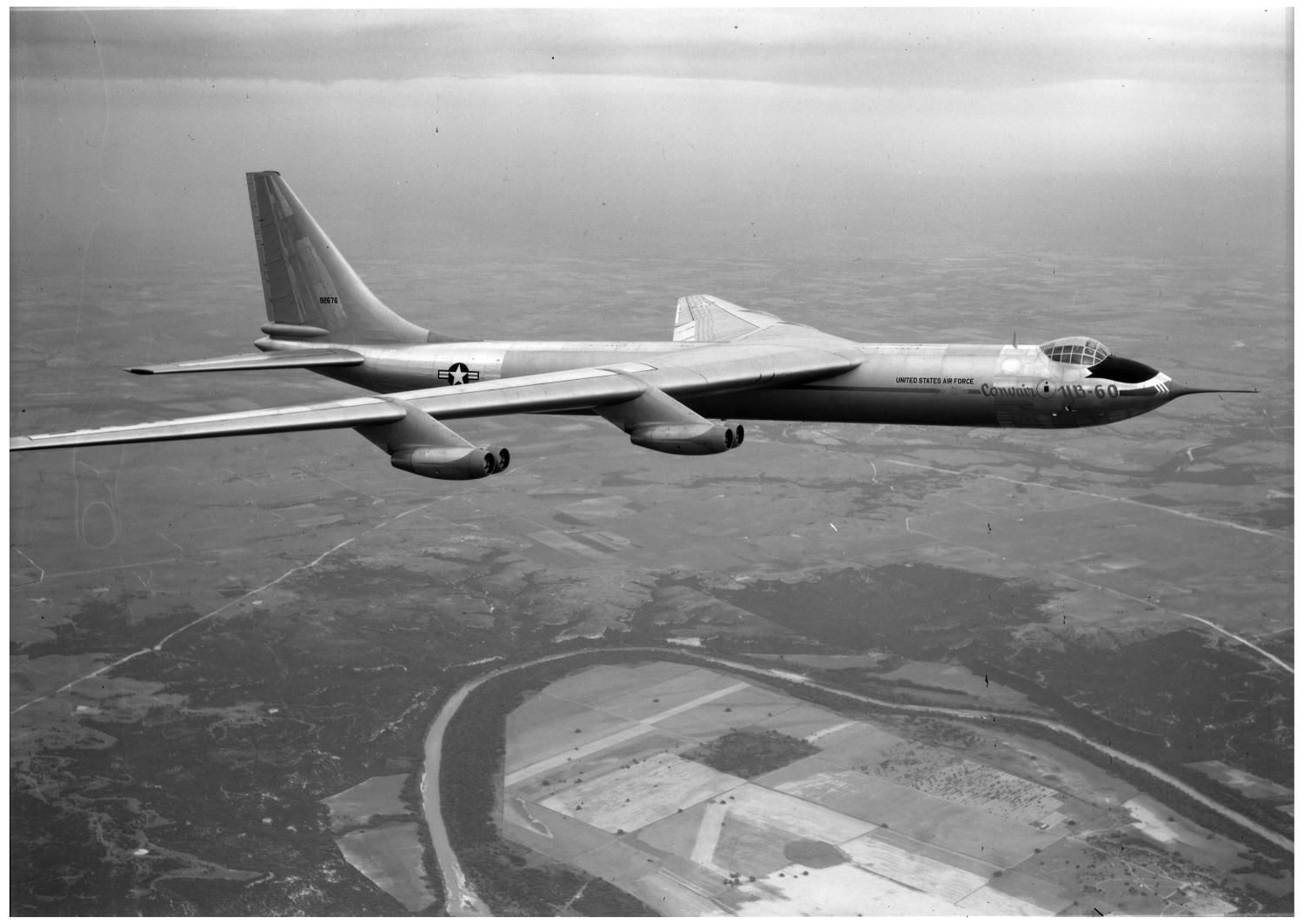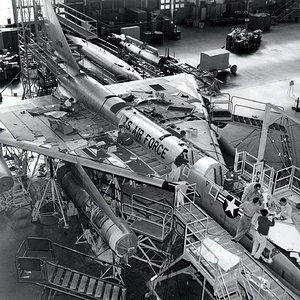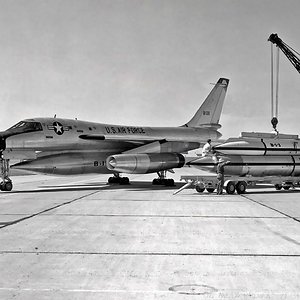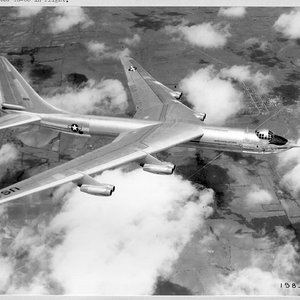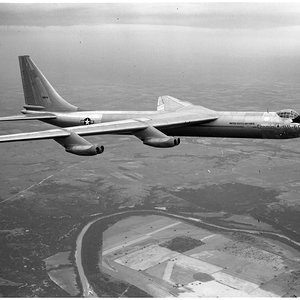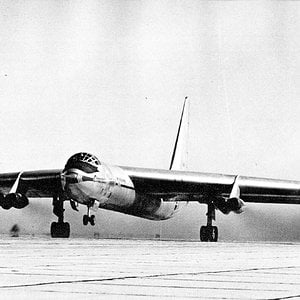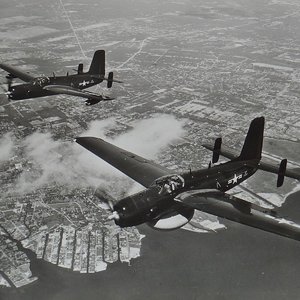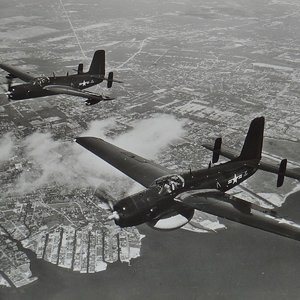Navigation
Install the app
How to install the app on iOS
Follow along with the video below to see how to install our site as a web app on your home screen.
Note: This feature may not be available in some browsers.
More options
You are using an out of date browser. It may not display this or other websites correctly.
You should upgrade or use an alternative browser.
You should upgrade or use an alternative browser.
Design and development
On 25 August 1950, Convair issued a formal proposal for a swept-winged version of the B-36 with all-jet propulsion. The United States Air Force was sufficiently interested that on 15 March 1951, the USAF authorized Convair to convert two B-36Fs (49-2676 and 49-2684) as B-36Gs. Since the aircraft was so radically different from the existing B-36, the designation was soon changed to YB-60.
The YB-60 had 72% parts commonality with its piston-engined predecessor. The fuselages of the two aircraft were largely identical, although the YB-60 had a longer, pointed nose with a needle-like instrument probe instead of the B-36's rounded nose, its tail surfaces were swept to match the wings and a with a wedge-shaped insert added at the wing root. The swept wings also used many of B-36 parts.
The YB-60's unofficial competitor for an Air Force contract was Boeing's B-52 Stratofortress. Convair's proposal was substantially cheaper than Boeing's since it involved modifying an existing design rather than starting from scratch. Like the B-52, it was powered by eight Pratt & Whitney J57-P-3 turbojets mounted in pairs in four pods suspended below the wing.
Instead of the B-36's crew of 15, the YB-60's crew numbered only ten. Production B-60s were to have defensive armament similar to the B-36.
Convair YB-60 serial number 49-2676 made its maiden flight on 18 April 1952, piloted by Beryl Erickson. The Boeing YB-52 beat the Convair aircraft into the air by three days. The YB-60 was approximately 100 mph (160 km/h) slower than the YB-52 and also had severe handling problems. It carried a heavier bomb load—72,000 pounds against 43,000 pounds (20 t) for the YB-52—but the Air Force did not see the need for the extra capacity given the YB-60's other drawbacks. Later "big belly" modifications increased the B-52's bomb load to 60,000 lbs.
The flight test program was canceled on 20 January 1953 with 66 flying hours accumulated, and a second prototype was never completed. The airframe was built, but it was not fitted with engines or much other equipment. Since Convair completed their prototype contract satisfactorily, both YB-60s were formally accepted by the Air Force in 1954. The operational aircraft never flew again, and both airframes were scrapped by July.
[edit]Specifications (YB-60)
A YB-60 in flight.
General characteristics
Crew: 5 (2 pilots ,navigator ,bombardier /radio operator ,radio operator/tail gunner )
Length: 171 ft (52.1 m)
Wingspan: 206 ft (62.8 m)
Height: 60 ft 6 in (18.4 m)
Wing area: 5,239 ft2 (486.7 m2)
Empty weight: 153,016 lb (69,407 kg)
Loaded weight: 160,000 lb (73,000 kg)
Max. takeoff weight: 300,000 lb (140,000 kg)
Powerplant: 8 × Pratt & Whitney J57-P-3 turbojets, 8,700 lbf (38 kN) each
Performance
Maximum speed: 508 mph (411 knots, 818 km/h) at 29,250 ft (8,915 m)
Stall speed: 115 knots (132 mph, 212 km/h)
Combat radius: 2,920 mi (2,540 nm, 4,700 km)
Ferry range: 8,000 mi (7,000 nm, 13,000 km)
Service ceiling: 53,300 ft (16,200 m)
Rate of climb: 1,060 ft/min (5.38 m/s)
Wing loading: 31 lb/ft2 (150 kg/m2)
Thrust/weight: 0.44
Armament
Guns: 2× 20 mm (0.787 in) cannon in tail
Bombs: 72,000 lb (33,000 kg)
On 25 August 1950, Convair issued a formal proposal for a swept-winged version of the B-36 with all-jet propulsion. The United States Air Force was sufficiently interested that on 15 March 1951, the USAF authorized Convair to convert two B-36Fs (49-2676 and 49-2684) as B-36Gs. Since the aircraft was so radically different from the existing B-36, the designation was soon changed to YB-60.
The YB-60 had 72% parts commonality with its piston-engined predecessor. The fuselages of the two aircraft were largely identical, although the YB-60 had a longer, pointed nose with a needle-like instrument probe instead of the B-36's rounded nose, its tail surfaces were swept to match the wings and a with a wedge-shaped insert added at the wing root. The swept wings also used many of B-36 parts.
The YB-60's unofficial competitor for an Air Force contract was Boeing's B-52 Stratofortress. Convair's proposal was substantially cheaper than Boeing's since it involved modifying an existing design rather than starting from scratch. Like the B-52, it was powered by eight Pratt & Whitney J57-P-3 turbojets mounted in pairs in four pods suspended below the wing.
Instead of the B-36's crew of 15, the YB-60's crew numbered only ten. Production B-60s were to have defensive armament similar to the B-36.
Convair YB-60 serial number 49-2676 made its maiden flight on 18 April 1952, piloted by Beryl Erickson. The Boeing YB-52 beat the Convair aircraft into the air by three days. The YB-60 was approximately 100 mph (160 km/h) slower than the YB-52 and also had severe handling problems. It carried a heavier bomb load—72,000 pounds against 43,000 pounds (20 t) for the YB-52—but the Air Force did not see the need for the extra capacity given the YB-60's other drawbacks. Later "big belly" modifications increased the B-52's bomb load to 60,000 lbs.
The flight test program was canceled on 20 January 1953 with 66 flying hours accumulated, and a second prototype was never completed. The airframe was built, but it was not fitted with engines or much other equipment. Since Convair completed their prototype contract satisfactorily, both YB-60s were formally accepted by the Air Force in 1954. The operational aircraft never flew again, and both airframes were scrapped by July.
[edit]Specifications (YB-60)
A YB-60 in flight.
General characteristics
Crew: 5 (2 pilots ,navigator ,bombardier /radio operator ,radio operator/tail gunner )
Length: 171 ft (52.1 m)
Wingspan: 206 ft (62.8 m)
Height: 60 ft 6 in (18.4 m)
Wing area: 5,239 ft2 (486.7 m2)
Empty weight: 153,016 lb (69,407 kg)
Loaded weight: 160,000 lb (73,000 kg)
Max. takeoff weight: 300,000 lb (140,000 kg)
Powerplant: 8 × Pratt & Whitney J57-P-3 turbojets, 8,700 lbf (38 kN) each
Performance
Maximum speed: 508 mph (411 knots, 818 km/h) at 29,250 ft (8,915 m)
Stall speed: 115 knots (132 mph, 212 km/h)
Combat radius: 2,920 mi (2,540 nm, 4,700 km)
Ferry range: 8,000 mi (7,000 nm, 13,000 km)
Service ceiling: 53,300 ft (16,200 m)
Rate of climb: 1,060 ft/min (5.38 m/s)
Wing loading: 31 lb/ft2 (150 kg/m2)
Thrust/weight: 0.44
Armament
Guns: 2× 20 mm (0.787 in) cannon in tail
Bombs: 72,000 lb (33,000 kg)

